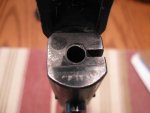Well, I wanted to share, to hopefully spare someone else the headache and heartache I went through last night. My new-to-me Anschutz 1827b (54 action) came in, and I was very excited. Thinking that most modern rimfires have controlled firing pin protrusion, and not being new to rimfires, I dry fired away blissfully enjoying the fan-fucking-tastic 5020 trigger, adjusting it to my tastes, dry firing some more, repeat repeat repeat.
After pulling the trigger probably at least 100 times, I happen to look in the open action and notice an indentation at 12:00 that wasn't there previously. FUCK! The barrel face had been peened by firing pin contact and the chamber was now slightly deformed. Doing a bit of research, I couldn't find anything definitive on the web about it, so I figured I would make a post about it. On Anschutz own website it does mention that an empty case "should" be used but it doesn't say specifically that damage can result.
The resolution is that I ordered a .22lr chamber iron. From what I understand, these repairs are not that big of a deal, and hopefully my accuracy isn't effected after the repair. I wanted to give everyone a heads up to hopefully prevent this from hapening to someone else.
-Bob
After pulling the trigger probably at least 100 times, I happen to look in the open action and notice an indentation at 12:00 that wasn't there previously. FUCK! The barrel face had been peened by firing pin contact and the chamber was now slightly deformed. Doing a bit of research, I couldn't find anything definitive on the web about it, so I figured I would make a post about it. On Anschutz own website it does mention that an empty case "should" be used but it doesn't say specifically that damage can result.
The resolution is that I ordered a .22lr chamber iron. From what I understand, these repairs are not that big of a deal, and hopefully my accuracy isn't effected after the repair. I wanted to give everyone a heads up to hopefully prevent this from hapening to someone else.
-Bob


